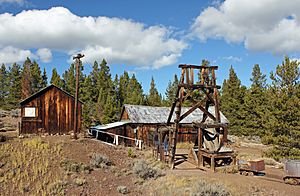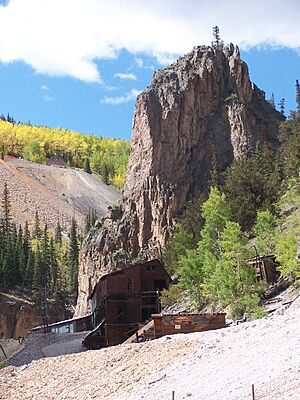Colorado Silver Boom facts for kids
The Colorado Silver Boom was a huge time of silver mining in Colorado during the late 1800s. It began in 1879 when lots of silver was found in Leadville. Miners dug up over $82 million worth of silver during this period. This was Colorado's second big mining boom, happening about 20 years after the shorter Colorado Gold Rush of 1859.
The boom grew because the U.S. Government started buying a lot of silver. This made silver more valuable. The boom lasted through the 1880s, bringing many new people and much wealth to Colorado, especially in the mountains. It ended in 1893 when silver prices crashed. This happened because a law called the Sherman Silver Purchase Act was canceled.
Contents
How the Silver Boom Started
Silver was first found in Colorado in the 1860s. Early mining happened in Clear Creek Canyon near Georgetown in 1864. At first, gold was more popular. Also, silver prices were low, so most mines didn't make enough money.
In 1878, the U.S. Congress passed a law called the Bland–Allison Act. This law made the government buy more silver. This raised the price of silver. Suddenly, many more mines could make a profit. When the rich silver deposits were found in Leadville the next year, many new prospectors rushed to the mountains. These were the same areas where the gold rush had happened earlier. Leadville became a very rich and fancy town.
Creede's Silver Story
Starting in 1889, Creede, Colorado also had a big silver boom. Silver was first found there in 1869. But it was hard to get the silver out of the rock and make money. The big "Boom Days" began when rich silver was found in Willow Creek Canyon.
Creede grew very fast. Its population jumped from 600 people in 1889 to over 10,000 by December 1891. The mines in Creede kept working until 1995. Creede was the last major silver boom town in Colorado during the 1800s.
Growth and Railroads
The silver boom kept going strong through the 1880s and early 1890s. Many historic buildings in Colorado's towns and cities were built during these years. The boom also led to many new railroad lines being built in the mountains.
For example, the Denver, South Park and Pacific Railroad built an early narrow-gauge line to Leadville. Also, extending the railroad up the Roaring Fork Valley to Aspen in the late 1880s made it possible to mine silver there. This saved Aspen from almost disappearing.
The End of the Boom
The U.S. government bought even more silver after the 1890 Sherman Silver Purchase Act. This helped the boom continue into the early 1890s. But when this act was canceled in 1893, silver prices dropped sharply. This brought the silver boom to an end.
After 1893, many mining towns became ghost towns. The economy in Colorado slowed down a lot. But farming, which people once thought wouldn't work, started to grow and helped the state's economy.
Dangers for Miners
Working inside the silver mines was often very dangerous. Miners could get a lung disease called silicosis, which had no cure back then. There were many other risks too. Mines were completely dark except for the lanterns or candles miners carried.
Miners also faced the danger of tunnels collapsing or mines flooding. Deeper parts of the mines often had very little oxygen. Miners sometimes brought caged canaries with them. If the bird passed out, it meant the air was unsafe. Mines were often small and tight to save money and time. This meant that smaller people, and sometimes even children, were used for mining.




